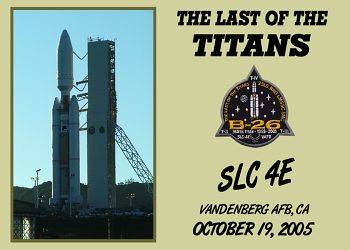
 |
I've witnessed dozens, from the stately departure of a Titan II to the raw power of a Space Shuttle. By day or night they provide a spectacular show unlike anything else.
For observers, the event begins with an hour or more of waiting and hoping it doesn't scrub due to adverse weather conditions or technical problems. You can see the rocket sitting on its launch pad, motionless except for thin streamers of propellants venting from the fuel tanks. Occasionally the public address system blares forth some comment from the launch controller, or just chatter from Mission Control.
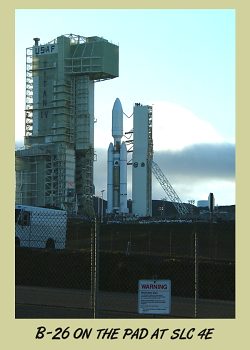 |
"Guidance?" "GO!" "Propulsion?" "GO!" "Payload?" "GO!" "Weather?" "GO!"
The sense of anticipation is palpable. You can hear it in their voices. It is known as "GO fever." It ends with the flight controller's final determination:
"All systems GO. We are GO for launch!"
Time seems to simultaneously compress and expand. Minutes turn into seconds that feel like hours. Finally it's time for terminal countdown from ten seconds.
Nine. Eight. Seven. Six. Five. Four. Three. Two. One. Ignition and liftoff. We have liftoff!
At the moment of main engine start you see the bottom of the rocket light up with a white orange glow. The vehicle suddenly rises. In total silence.
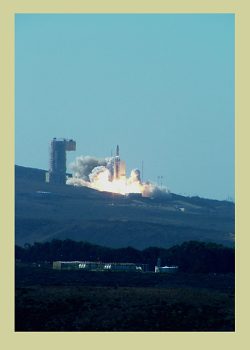 |
If there is water between you and the pad, you might suddenly notice a ripple. Then it hits. The sound: a low boom, followed by a crackling thunder that rises in its intensity. The launch pad is a couple miles away, so it took a while for the sound to reach you. Now it begins to shake your insides as the rocket climbs majestically into the sky.
If it is a night launch the intense brightness of the rocket's plume illuminates the landscape for miles around. Night turns briefly to day until the vehicle is far enough downrange for its glow to subside.
The rocket becomes a solitary bright dot in the sky. Its smoke trail twists in the high-altitude winds, creating a bizarre aerial display. Silence returns to the launch pad. Of course, any rocket launch is spectacular. I once told an Air Force public affairs spokesman that I was happy to drive several hours, in predawn darkness and fog, with little sleep, as long as there was a slight chance I would get to see something tube-shaped with fire coming out one end.
I've seen the mighty Atlas, slender Delta and awesome Shuttle, but I will always have a special place in my heart for the Titan 4. I saw my first, a Commercial Titan CT-4, carrying the Mars Observer spacecraft from Cape Canaveral, Fla., in 1992. The following year, Tony Moore and I started covering launches at Vandenberg Air Force Base (near the town of Lompoc, Calif.) for a couple of different publications. Each expedition to what I like to call "the fog-shrouded California Space Coast" was an excellent adventure, even if we had to endure a few scrubbed launches. Over the years we had the opportunity to witness several Titan 4 launches, including the final one.
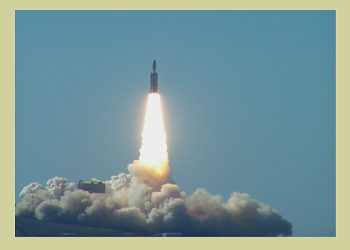 |
More than 140 Titan ICBMs, built by the Martin Company and Martin Marietta Corporation, served as the vanguard of America's nuclear deterrent force for 23 years. NASA selected the Titan 2 as a space launch vehicle for the Gemini manned space program in 1961. In the mid 1960s, the Titan 3 series was born, spawning a family of vehicles that boosted 82 military and civilian satellites into orbit between 1965 and 1982. Titan 3E rockets with Centaur upper stages carried Viking and Voyager planetary science missions into space. The larger Titan 4 expendable space launch vehicle was originally developed as a backup for the space shuttle in the late 1980s, but became a mainstay for heavy Defense Department payloads such as reconnaissance satellites.
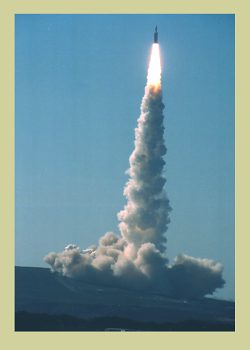 |
The NRO is a hybrid organization consisting of some 3,000 personnel and jointly staffed by members of the armed services, Central Intelligence Agency and DOD civilian personnel. The director of the NRO also serves as undersecretary of the Air Force, a presidential appointee and the executive agent for the DOD Space System Acquisition.
The NRO, sometimes called "Freedom's Sentinel in Space," designs, builds and operates the nation's reconnaissance satellites. Using NRO products, customers within the Intelligence Community can warn the president of potential trouble spots around the world, help plan military operations, and monitor the environment.
During the 1990s, the NRO implemented a series of actions declassifying some of its operations. In February 1995, CORONA, a photoreconnaissance program in operation from 1960 to 1972, was declassified and 800,000 CORONA images were transferred to the National Archives and Records Administration. In December 1996, the NRO announced for the first time, in advance, the launch of a reconnaissance satellite.
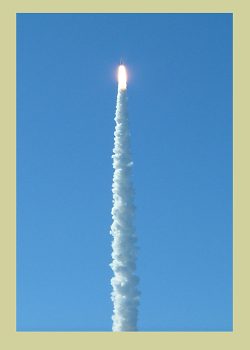 |
Liftoff was scheduled for mid-afternoon and, for once the "Vandenberg fog festival," as Tony called it, was off. The weather was perfect.
Once in place at the viewing site, we could see the Titan 4A, designated K-13, on the launch pad. After a moderate wait, we listened to the terminal countdown and watched the rocket blast off toward space. It was magnificent.
Later, we were told the satellite reached orbit successfully. The payload was classified, but aerospace analysts speculated that it was a CRYSTAL-II reconnaissance satellite. Tony and I again made the five-hour drive to Vandenberg on 23 October 1997 for the launch of Titan 4A (K-18), believed to be carrying a LACROSSE/VEGA signals intelligence (SIGINT) satellite. This time it was a night launch. At the viewing site, one inexperienced reporter asked: "Will we be able to see it from here?"
"Oh, yeah," I replied. A short while later K-18 turned night into day as it soared into the heavens.
On 22 May 1999, predawn fog obscured our view of Titan 4B (B-12) for nearly 30 seconds. The rocket's plume illuminated the mist in an eerie glow. Suddenly the vehicle became visible through a hole in the clouds. Another NRO payload was on its way to orbit.
Our attempt to get a close-up view of the Titan 4B (B-28) launch was thwarted when the mission was scrubbed on 16 August 2000. We had to settle for a distant view the following day, from the parking lot of NASA Dryden Flight Research Center at Edwards Air Force Base.
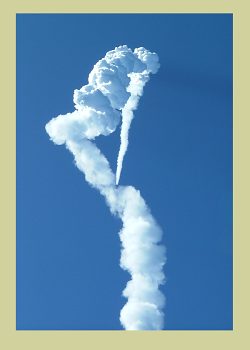 |
Tony and I drove to Lompoc in the predawn darkness of 19 October 2005. We were met by Air Force public affairs personnel at the gate to Vandenberg's South Base and escorted to the launch pad at Space Launch Complex 4E. As the eastern sky took on a golden glow we watched the service structure roll back to reveal the Titan, its classified payload (believed to be a CRYSTAL II satellite) hidden within a white shroud. After a while we retreated to a safe distance to view the launch.
The last Titan heavy-lift space booster, Titan 4B (B-26), soared into a clear blue sky at 11:05 a.m. PDT. It was the 12th Titan 4 launched from Vandenberg; 27 others lifted off from Cape Canaveral Air Force Station, Fla. Four major variants, and numerous sub-variants of Titan, have lofted payloads into orbit since 1959. This was the 200th Titan to fly from the West Coast and the 368th flight of a member of the Titan booster family.
It was a complete success. We watched as the rocket climbed upward and arced over in a southerly trajectory, shedding its two solid-propellant boosters as it headed into orbit. As the smoke cleared away from SLC 4E we experienced a bittersweet moment, realizing this was the end of an era.
